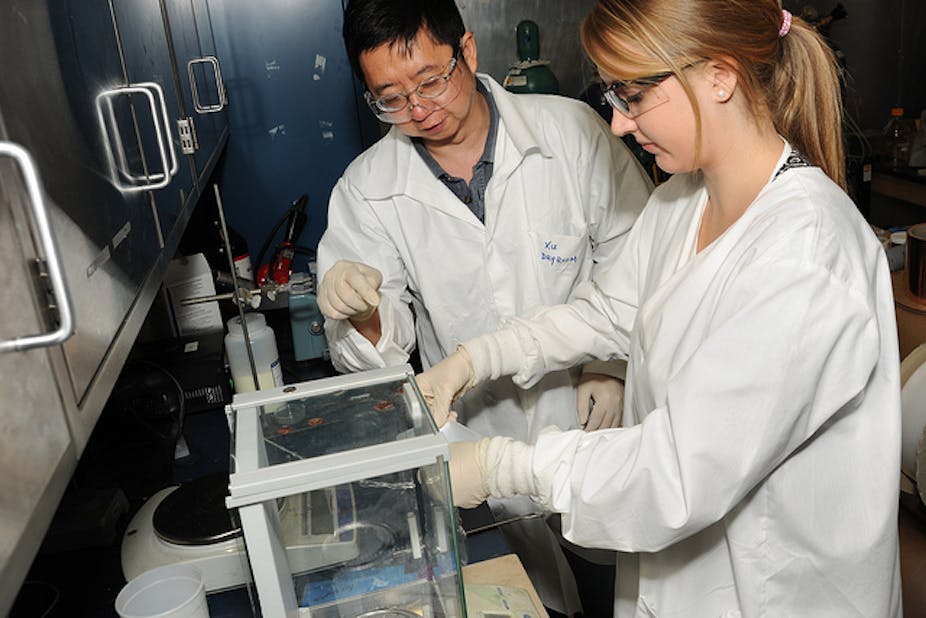Most researchers would agree with the Commission of Audit’s finding that “given overall budget constraints, it is important to take a strategic, whole-of-government approach to where Australia’s research dollars are spent”.
Indeed, I think researchers would go further and say that this must be part of an ongoing conversation between the research sector, industry, government and the community.
For the Commission of Audit process to have a positive impact, the report must be seen as a first step in a broader long-term, strategic, whole-of-government plan for the entire research and innovation sector – something Australia has not had for many years.
The report’s recommendations fall into three groups: merging previously distinct funding bodies and cutting entire programs; reducing “red tape”; and structural reform of funding to create more certainty.
Merging and cutting
Merging smaller agencies that fund research into larger bodies makes some sense. Savings can potentially be made by reducing duplicated administration and the possibility of a single overarching research strategy, rather than fragmented goals, is alluring.
The risk in these proposals is that the culture of successful niche programs will be lost in monolithic super-agencies. As with so many of the commission’s recommendations, the devil will be in the detail.
For example, the recommendation to combine the National Health and Medical Research Council, Cancer Australia and the Australian National Preventative Health Agency into a National Health and Medical Research Institute appears sound, provided the crucial role preventative health research plays in the long-term sustainability of the health system is enhanced, not eroded.
Likewise, the Co-operative Research Centres program is rightly seen as one of the success stories of Australian research and innovation, bridging the gulf between academics and end users of research in industry and the community. The risk of rolling this funding into a Super-Australian Research Council (recommendation 34) is that the collaborative industry focus of Co-operative Research Centres will be lost.
International indicators show that Australia produces high-quality research, but is less good at developing research results to capture economic benefit. Over the last decade support for development has eroded. In 2008, the previous government scrapped the widely regarded Commercial Ready program without providing an alternative. As a result innovation has languished.
The Commission of Audit recommends abolishing the Industry Innovation Precincts Program, Industry Collaboration Fund and the Australian Research Council Linkage - Industrial Transformation Research Program, yet how it intends to better develop Australia’s smart ideas is not clear.
Reducing red tape
The time it takes Australian researchers to apply for funding and to review funding applications has grown substantially in the last 20 years. This is now a major barrier to productivity. The Commission of Audit identifies a number of ways to cut, or streamline, the administrative red tape that binds researchers.
An obvious suggestion made by the commission is to increase the duration of grants so that researchers have to apply less often. This and other recommendations should be considered as part of a broader overhaul of the grant funding processes. This is something that is needed not just in Australia but is recognised as an international problem.
In ensuring an efficient and responsive grant allocation system, we should be mindful that both the National Health and Medical Research Council and the Australian Research Council operate with a core secretariat that is extremely lean. While there is no doubt that processes can be refined, there is also an argument that administration funding should be enhanced, rather than cut.
Funding to create more certainty
The commission makes two key suggestions which should be adopted quickly and fully.
The first is proper long-term funding of critical research infrastructure such as genome centres, the Synchrotron and Antarctic research vessels. The on-again, off-again funding of these facilities creates uncertainty and erodes the effectiveness of the Australian research endeavour.
The entire research sector would breathe a sigh of relief should long-term funding for essential infrastructure be supported in a bipartisan way that enabled both academic and industry groups to access these scientific facilities and services on affordable terms. To do this requires that highly qualified people be viewed by government as an essential part of our national infrastructure network, with funding provided not just for equipment but also for the highly specialised technologists.
The second involves looking at better alignment of funding for the direct and indirect costs of research. The current system of funding for the indirect costs of research (including costs to run research organisations, such as power, support staff and laboratory equipment) is inefficient, inequitable and burdened with red tape.
Funding for the indirect costs of research is arguably the number one issue affecting the productivity of the research sector. The current system has been recognised as being worse than ineffective by every government review of research and innovation in the last 20 years (The Wills Review, Grant Review and McKeon Review), yet little has changed.
If the Commission of Audit manages to bring about funding for the indirect costs of research, then many in the sector will view the exercise as a success, but it’s only the first step.

